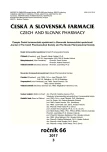Drugs and dosage forms as risk factors for dental caries
Authors:
Petra Bořilová Linhartová; Lydie Izakovičová Hollá
Published in:
Čes. slov. Farm., 2017; 66, 103-106
Category:
Review Articles
Overview
Dental caries is a multifactorial disease which, despite a series of preventive measures, remains the most common infectious disease worldwide. Susceptibility or resistance to caries may be a result of the presence of risk or protective factors, genetic predisposition, inappropriate lifestyle associated with education, behavioural and socioeconomic factors. The aim of this review is to highlight the risks associated with the use of some drugs and dosage forms in relation to the formation and development of dental caries. Drugs are classified by the mechanism of their action in this process, into those that 1. influence the tooth development, especially enamel, 2. directly or indirectly damage the tooth structure and/or 3. disrupt the protective function of saliva, causing oral microflora dysbiosis. The review article assesses the current possibilities in the treatment and prevention of dental caries using drugs, dietary supplements and supporting measures. The conclusion of the study deals with recommendations for prevention of adverse effects of drug therapy in the oral cavity, through preventive measures and/or by considering the duration of the treatment to achieve an optimal balance between benefits and risks. Since the topic of the study is of an interdisciplinary character, information on prevention within the oral health improvement in the population can be used not only by pharmacists, who should primarily warn patients about the risks associated with pharmacotherapy, but also dentists, paediatricians/general practitioners and the public.
Key words:
dental caries • prevention • drug • dosage form • adverse effect
Sources
1. Drugs that promote dental caries. Prescrire Int. 2015; 24(157), 41–42, 44.
2. Billings R. J., Berkowitz R. J., Watson G. Teeth. Pediatrics. 2004; 113(4 Suppl), 1120–1127.
3. Jacobsen P. E., Henriksen T. B., Haubek D., Ostergaard J. R. Developmental enamel defects in children prenatally exposed to anti-epileptic drugs. PLoS One. 2013; 8(3), e58213.
4. Mastora A., Vadiakas G., Agouropoulos A., Gartagani-Panagiotopoulou P., Gemou Engesaeth V. Developmental defects of enamel in first permanent molars associated with use of asthma drugs in preschool aged children: A retrospective case-control study. Eur. Arch. Paediatr. Dent. 2017; 18(2), 105–111.
5. Carrillo C. M., Corrêa F. N., Lopes N. N., Fava M., Odone Filho V. Dental anomalies in children submitted to antineoplastic therapy. Clinics (Sao Paulo) 2014; 69(6), 433–437.
6. Nazir S., Naqvi S. N. U. H., Ahmed M., Arain A. H., Nazir, N. Effect of aspirin on the developing teeth of neonates. Int. J. Morphol. 2011; 29(1), 278–285.
7. Kargul B., Tanboga I., Ergeneli S., Karakoc F., Dagli E. Inhaler medicament effects on saliva and plaque pH in asthmatic children. J. Clin. Pediatr. Dent. 1998; 22(2), 137–140.
8. Valinoti A. C., da Costa L. C. Jr., Farah A., Pereira de Sousa V., Fonseca-Gonçalves A., Maia L. C. Are pediatric antibiotic formulations potentials risk factors for dental caries and dental erosion? Open Dent. J. 2016; 10, 420–430.
9. Roberts I. F., Roberts G. J. Relation between medicines sweetened with sucrose and dental disease. Br. Med. J. 1979; 2(6181), 14–16.
10. Chu J., Zhang T., He K. Cariogenicity features of Streptococcus mutans in presence of rubusoside. BMC Oral Health. 2016; 16(1), 54.
11. Assaf D., Steinberg D., Shemesh M. Lactose triggers biofilm formation by Streptococcus mutans. Int. Dairy J. 2015; 42, 51–57.
12. Miranda-Rius J., Brunet-Llobet L., Lahor-Soler E., Farré M. Salivary secretory disorders, inducing drugs, and clinical management. Int. J. Med. Sci. 2015; 12(10), 811–824.
13. Trackman P. C., Kantarci A. Molecular and clinical aspects of drug–induced gingival overgrowth. J. Dent. Res. 2015; 94(4), 540–546.
14. Lozano Moraga C. P., Rodríguez Martínez G. A., Lefimil Puente C. A., Morales Bozo I. C., Urzúa Orellana B. R. Prevalence of Candida albicans and carriage of Candida non-albicans in the saliva of preschool children, according to their caries status. Acta Odontol. Scand. 2017; 75(1), 30–35.
15. Patil S., Rao R. S., Majumdar B., Anil S. Clinical appearance of oral candida infection and therapeutic strategies. Front. Microbiol. 2015; 6, 1391.
16. Jainkittivong A., Kuvatanasuchati J., Pipattanagovit P., Sinheng W. Candida in oral lichen planus patients undergoing topical steroid therapy. Oral Surg. Oral Med. Oral Pathol. Oral Radiol. Endod. 2007; 104(1), 61–66.
17. Li Y., Tanner A. Effect of antimicrobial interventions on the oral microbiota associated with early childhood caries. Pediatr. Dent. 2015; 37(3), 226–244.
18. Kalesinskas P., Kačergius T., Ambrozaitis A., Pečiulienė V., Ericson D. Reducing dental plaque formation and caries development. A review of current methods and implications for novel pharmaceuticals. Stomatologija. 2014; 16(2), 44–52.
19. Twetman S., Dhar V. Evidence of effectiveness of current therapies to prevent and treat early childhood caries. Pediatr. Dent. 2015; 37(3), 246–253.
20. Hajishengallis E., Parsaei Y., Klein M. I., Koo H. Advances in the microbial etiology and pathogenesis of early childhood caries. Mol. Oral. Microbiol. 2017; 32(1), 24–34.
21. Ministerstvo zdravotnictví ČR. Zdraví pro všechny v 21. Století, 2002. http://www.mzcr.cz/Verejne/dokumenty/zdravi-pro-vsechny-v-stoleti_2461_1101_5.html (8. 4. 2017).
22. Bartlett D. W. The role of erosion in tooth wear: aetiology, prevention and management. Int. Dent. J. 2005; 55(4 Suppl 1), 277–284.
Labels
Pharmacy Clinical pharmacologyArticle was published in
Czech and Slovak Pharmacy

2017 Issue 3
Most read in this issue
- Herpes simplex virus infection: an overview of the problem, pharmacologic therapy and dietary measures
- Drugs and dosage forms as risk factors for dental caries
- The extent of the burnout syndrome among pharmacists: partial study
- The role of a hospital pharmacist in the management of asthma in Great Britain
